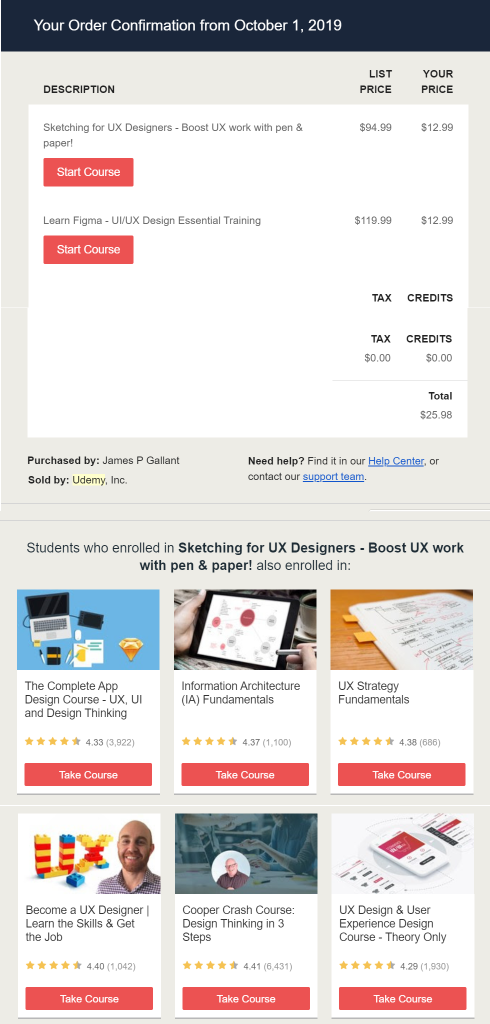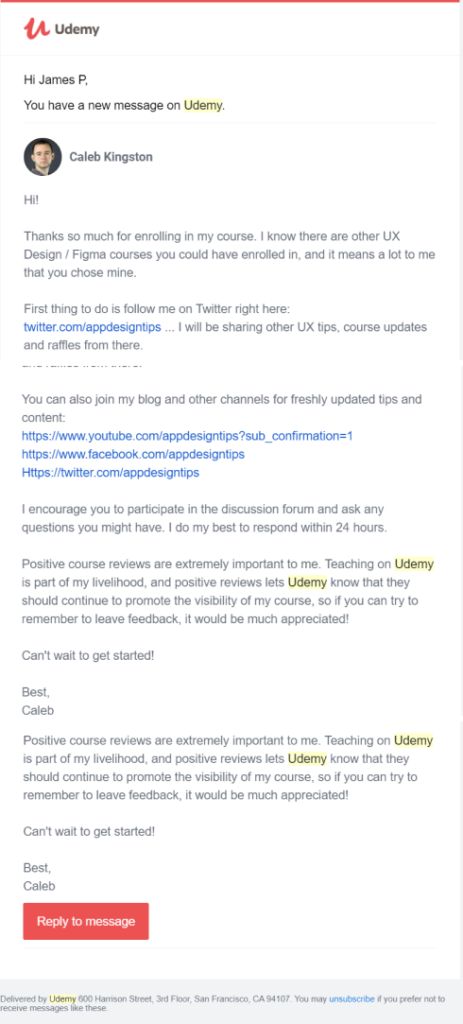The UX Writing course I’m taking tasked me with creating a digital product. That entailed opting in to competitors’ communications to analyze their brands’ language. Soon, like a bad cold, email had infiltrated every nook and cranny of my inbox.
Instinctively I’ve considered most emails to be marketing content because they try to get me to buy. Or sometimes they communicate some value by providing discounts, useful tips, or helpful reminders. But many emails don’t fit neatly into the marketing-message bucket.
Neither promotional nor part of a drip campaign, this other broad category of emails comes in familiar flavors:
- Updates to products, service agreements, and privacy terms
- Newsletter subscription confirmations
- Welcome letters
- Purchase receipts
- Shipping information
- Onboarding guidance
- System outage alerts
- Notifications and reminders
Little did I know that the industry has a name for these messages: transactional emails. Their job is to inform or educate customers by acknowledging their purchases or other actions, providing shipping details, alerting them to events, sharing product updates, and helping them learn to use products quickly.
Transactional Email Writing Is UX and Customer Experience (CX) Writing
Transactional emails’ focus on building, deepening, or maintaining a relationship between brand and customer. From the brand’s perspective, transactional emails play a critical role in bringing customers back to the brand’s platform. Because of their importance to customer experience, transactional emails increasingly are becoming the job of UX writers, especially at large companies.
At a small company, you’re probably writing both types of email. If you’re a marketer first, that’s great because you already practice principles in common with UX writing like:
- Referring to personas—Consulting them keeps your audience front and center.
- Incorporating research insights—Better understand customer needs and vocabulary via interviews, observations, surveys, and conversations.
- Following your company’s style guide—This is the key to writing consistently in your brand’s voice and with the tone appropriate to your target audience.
Writing for customers and prospects is a high-wire balancing act. You’re always considering your audience’s needs and your business’s goals. The critical difference in writing transactional emails is that you’ll hit your mark most often if you put your thumb on the customer side of the scale.
In simplest UX terms, that means leading with empathy when writing for customers. Make sure every transactional email delivers value to customers and does not try to upsell or cross-sell.
If you’re a marketing copywriter, develop a bloodhound’s nose for separating the wheat from the fluff, and when you smell fluff in what should be a transactional email, be fearless, and kill it.
Transactional Emails in Their Glory (and Warts)
Let’s look at three examples of transactional emails and how they serve their recipients.
My UX writing instructor Yuval Keshtcher recommends learning the basics of today’s design tools. When I began learning Figma, I visited the popular education site udemy and signed up for two courses, one on Figma, the other on sketching the UX.
I received an order confirmation immediately.

For a purchase confirmation, this is standard but necessary and useful stuff:
- Clear subject line—“Order Confirmation for October 1, 2019” says it all.
- Just the facts—Email shows me the courses ordered, their prices, and taxes.
- Help on the way—Prominent links direct me to udemy Help Center and support.
- Helpful CTA buttons—With one click, I can start either course.
- No fluff—Nothing overly promotional.
But in the lower half of the email, you see more courses udemy recommends. At least the email’s composer placed this information below what I really needed. Not a major faux pas, so I give this a B+.
Next, I received a welcome email.

This email is 90 percent markety-mark:
- Impersonal—What’s my name?
- But wait, there’s more—Clicking the “Start learning” button sent me to a page to search for more udemy courses.
- Benefits, then features—Most of this email is a brochure.
- Get the app—This CTA button doesn’t rankle me because the app could be useful for mobile learning.
The copy and visuals look to be copied from a brochure and pasted into this campaign. The marketing writer and graphic designer, hey, they did their jobs. Whoever approved this as the customer welcome email gets an F.
Then I received yet another welcome message from udemy.

Now this, this I can get on board with:
- Personalized—Addressing me as “James P” is nice, but including my middle initial is awkward.
- Personal—Kudos to udemy for having this message come from Caleb, the instructor, along with his photo.
- Invitations to connect—Links invite me to join Caleb’s design-tips communities on Twitter, Facebook, and YouTube.
- Personal brand promise—Caleb says he will reply to all outreach in 24 hours. Nice.
- Reply to this message—A CTA button to reach out to Caleb.
Caleb asks for a positive review if you like his course. To my eyes and ears, though, this doesn’t cross any line. It’s an excellent example of providing a great CX at the welcoming a new customer touchpoint. An A- for UX writing in practice, in a transactional email.
The distinctions between transactional and marketing emails will become clearer as more businesses invest in UX writing. In the meantime, read your inbox with a more critical eye and ear.
Notice which writing techniques educate, inform, and entertain, and which clearly (or subtly) market to you. Do that, and you will hone your Spidey sense for spotting—and writing—transactional emails that make a great UX and CX.
Keep learning
You can also read about email copywriting in this article from Respona.
About Jim Gallant
Lifelong writer, content strategist, environmental advocate, live music fiend, and dreadful guitarist at linkedin.com/in/jimgallant/



